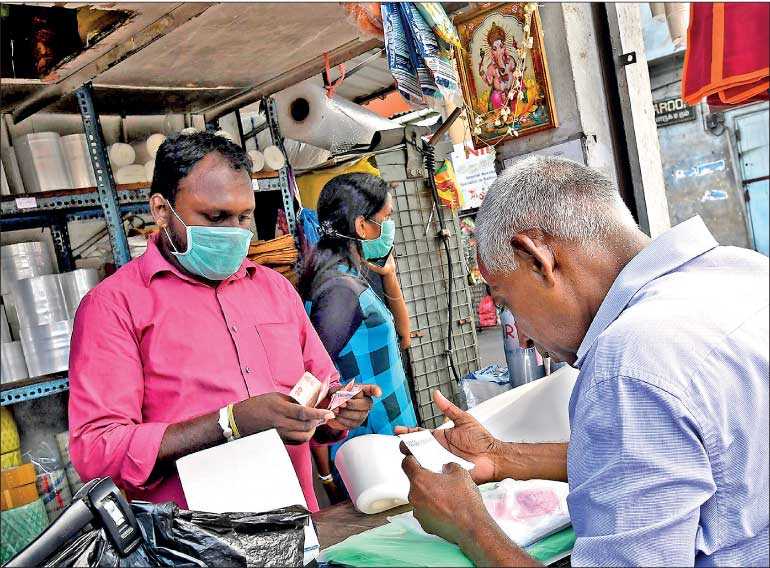Saturday Apr 19, 2025
Saturday Apr 19, 2025
Wednesday, 10 June 2020 00:00 - - {{hitsCtrl.values.hits}}

Daily wage earners and self-employed individuals together with a portion of the micro, small, and medium sized enterprises, have lost most of their livelihoods, resulting in the wellbeing of nearly half of the workforce being severely affected – Pic by Shehan Gunasekara
No industry has been spared. This simple phrase can summarise the effect of C19 on the global economy – inclusive of Sri Lanka. Compounding this situation for Sri Lanka is the fact that whilst we are still reeling from the devastating Easter 2019 attacks, the COVID-19 pandemic has created a local crisis of magnitude never before faced in our contemporary history.
In addition to dealing with the health and social crisis, the economic shock due to drop in demand, disruption of global supply lines as a result of confinement and import and export restrictions, and the resultant rise in unemployment, has effected multiple blows on an already fragile economy.
Additionally, at high risk are tens of thousands of jobs – companies are already moving ahead with salary reductions, decreasing their respective workforce or employing other cost reducing strategies. Daily wage earners and self-employed individuals together with a portion of the micro, small, and medium sized enterprises, have lost most of their livelihoods, resulting in the wellbeing of nearly half of the workforce being severely affected.
The situation is further exacerbated by the daunting challenge of meeting this year’s debt repayment of over $ 3 billion which is due between May and December 2020. The Government has requested relief in the form of deferment of dues, and a suspension of debt repayments for the next two years from its lenders; and with the encouragement of the World Bank and International Monetary Fund and G20 economies, the global debt suspension initiative could assist the country gain some flexibility and breathing space to mitigate this crisis.
As Sri Lanka is highly sensitive to any reduction of foreign currency generation – the significant decline in exports compounded by a virtually still tourism market, deterioration of inward remittances, the global economic slowdown, debt servicing obligations and depreciation of the rupee, has pushed the Sri Lankan economy to the brink of a foreign exchange crisis.
The Central Bank of Sri Lanka, in a bid to curtail the impact on foreign exchange reserves, have taken measures of restricting non-essential product imports and eased restrictions in the inflow of foreign currency through special FX deposit accounts.
The President, Government, medical and civil service and tri forces deserve to be lauded for efficiently containing the spread of the C19 outbreak. However the upcoming economic challenge, whilst continuing to contain the virus until an effective vaccine is developed, is unenviable.
It is a situation the GOSL will not be able to answer singlehandedly but will require Sri Lanka as a whole – our universities, enterprises of all sizes, business chambers, thinkers, professionals amongst all its peoples – to work towards its success. We will need to innovate, adapt and re-model our businesses, careers and abilities to pivot successfully in to the evolving needs of global demand, supply platforms and regulatory changes in this C19 world.
Seizing opportunities
It was the great Philosopher Socrates who said, “The secret of change is to focus all your energy, not on fighting the old, but on building the new” and as we find that we are forced into evolving in thought and action – both personally and professionally – there is no time like the present to size the unique and unexpected opportunities Sri Lanka and Sri Lankan businesses are faced with.
Supply chain shifting
A visible fallout of C19 has been the risk to global trade from excessive dependence of global supply chains on a few countries. For example, when factories across China closed during the initial outbreak of C19 in Wuhan, there was an unforeseen, and largely unavoidable impact for many global manufacturers, and buyers, that forced them to scramble for alternatives.
Many companies had to stop operations or operate well below capacity because critical components, raw materials or finished goods could not be sourced on time. International reaction was swift, with representatives of three of the world’s four largest economies – The USA (Sri Lanka’s largest trading partner), Japan and the EU publicly encouraging companies to shift their manufacturing operations out of China as part of plans to relocate, or risk mitigate, their supply chains and diversify the global industry.
As such with companies across the globe now actively seeking new suppliers and manufacturing locations to diversify their supply-chains, the opportunity for Sri Lankan businesses to meet this demand is phenomenal.
Both the private sector and the government, have an opportunity to jointly and aggressively promote Sri Lanka’s geographic advantage, rich human-capital and ability to cater to high-end knowledge services and high-tech manufacturing in the region.
At the time of this article – Apple, Google and Microsoft have already moved some significant sourcing from China to the ASEAN region.
Sri Lanka-US trade
The USA is the largest single export destination for Sri Lanka absorbing over 25% of our total exports. In 2018, the value of Sri Lankan exports to the USA stood at $ 3.1 million, the highest recorded in trading history between the two countries.
Apparel products account for over 70% of total exports, while other products include solid tyres, pneumatic rubber tyres, rubber gloves, articles of vulcanised rubber, tea, fisheries products, cinnamon, activated carbon, precious stones etc.
US businesses, and the companies that export to the USA currently employ over 250,000 people and represent some of the largest companies in the world in the region, bringing world class technology, education, manufacturing and services to our nation.
The US being a significant net importer of Sri Lankan products and services, provides us with valuable foreign currency through trade.
Hence any shift in supply chains, from other nations to Sri Lanka, can have a significant positive effect on the economy and its fiscal health.
Sri Lanka is also one of the beneficiaries of the United States’ GSP Program, the largest and oldest preferential scheme of the USA which allows duty concessions for goods from selected countries, and one of the key opportunities that Sri Lankan businesses engaged in bilateral trade with the USA could benefit from is this system, by re-purposing and pivoting their business strategies to align with the categories of the GSP Program.
The USA also provides significant opportunities and support to private organisations to promote bilateral trade through trade finance, technology transfers, funding opportunities and networking through its various in-country partners.
Re-strategise, re-purpose
In this era driven by technology and connectivity, the new Darwinism “Innovate or Perish” has been a mantra for a while – but it was not till COVID-19 hit our lives and livelihoods maybe that we truly understood the reality of those simple yet infinitely loaded three words.
Over the past three months in Sri Lanka businesses have been compelled to innovate and adapt, adopt new strategies and directions, and re-purpose their resources – and while some like several in the apparel sector now manufacturing PPE, or FMCG retailers now providing transportation, medical services and accommodation – have done so effectively and successfully, many others are still challenged to catalyse the vision, acumen and resources required to pivot their business models to meet the current climate.
The bounce-back initiative
The American Chamber of Commerce in Sri Lanka (AmCham SL) has over the past eight weeks created and curated a series of thought leadership events and resources aimed at providing news, information, knowledge and resources to its members to navigate the pandemic resultant ‘Great Lockdown’.
Now as we emerge into a phase of recovery, The AmCham SL has initiated a series of similar resources under the theme the ‘Bounce-Back Initiative’ aimed at opening discussions, promoting research, exchanging information and engaging with the business community providing insights and provoking thought around opportunities such as those identified above.
The first of this series of resources which will feature webinars, interviews and publications is a webinar to be held on Thursday 11 June at 4 p.m., where AmCham SL will facilitate a conversation with four experts in the areas of economy, medicine, sociology and geo-politics/international relations, who will provide thought provoking insight to the C19 resultant status quo and identify the opportunities that Sri Lanka and Sri Lankan businesses can harness.
The pandemic has indeed accentuated the necessity and urgency of diversification and restructuring of businesses and global supply chains. For a country such as Sri Lanka, with a key geographic advantage, rich human-capital, high-end knowledge services and high-tech manufacturing; cohesive collaboration between the Government and businesses to shift the paradigm and move this opportunity from rhetoric to reality is the need of the hour.
As such we invite you to join the AmCham SL ‘Bounce-Back’ conversations to push the boundaries in our minds and explore possibilities to move Sri Lanka from a survival mode to that of complete revival and a global leadership in the future.
(The writer is the President of AMCHAM Sri Lanka. An entrepreneur, investor, and Co-founder of Pyxle and Elyon Hotels.)